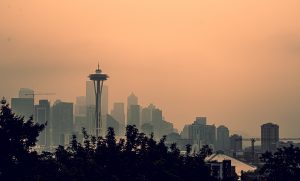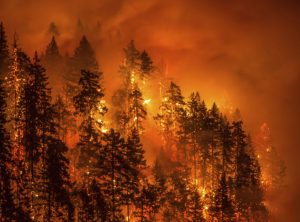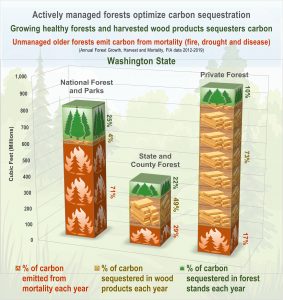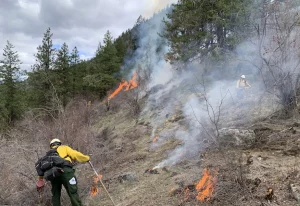Fire, drought, insect infestations, disease outbreaks and weather-related disturbances have always been a part of the natural forest cycle.
It’s true fire can be beneficial in maintaining a healthy balance in forests by lowering the accumulation of fuel levels and allowing for ample space for trees to grow. Yet the destructive fires that have dominated news headlines the past several years has drawn concern from people outside of the forestry sector.

Haze and smoke from the 2023 Canadian wildfires blanketed the skies in Seattle and throughout the state.
Attention on wildfire and its widespread effects have only increased as more people are impacted. Medical experts warn against the health risks associated with wildfire smoke and forestry experts have documented the alarming amount of greenhouse gases released in large-scale fires.
The recent spate of devastating blazes reflects decades of flawed (albeit well intentioned) forest policies coupled with longer, hotter summers brought on by climate change and other forest stressors. Past policies and inaction have created densely packed forests with an excess of combustible vegetation and dead/dying trees that have made forests more vulnerable to disturbances and fire.

But it doesn’t have to be that way. Washington can avoid a future where megafires are the “new normal” and wildfire smoke blankets the skies each summer.
This is where active forest management is critical, and a better understanding of wildfire facts can benefit our forests, environment, economy and quality of life. A growing body of evidence, research, studies and best practices affirm that forest management improves forest resilience and reduces catastrophic wildfire risk.
In fact, managing forests to reduce wildfire severity has bipartisan support. Most public lands commissioner candidates say they support forest management approaches like thinning, prescribed fire and harvests as a means of promoting healthy, resilient forests and supporting local economies.

In 2023, Washington state had a total 1,880 wildfires – the second-highest number on record. However, the number of acres burned (165,000) was significantly lower than the yearly average of 470,000 due in large part to intentional efforts made by the Department of Natural Resources and communities to restore balance in forests.
Public Lands Commissioner Hilary Franz noted that recent state investments, strategic partnerships and policy changes have allowed the state to ramp up wildfire response and address forest health concerns. These efforts include expanding the Department of Natural Resources’ air fleet, applying new technologies like LiDAR to assess forest health and resuming proven-effect forest management methods like prescribed fire and thinning.

DNR firefighters start a prescribed burn in the Sinlahekin Wildlife Area in March 2022. Photo courtesy of the Washington State Department of Natural Resources.
“It wasn’t luck that left us with blue skies most of the summer and early fall,” said Franz during a 2023 wildfire season briefing. “It was leadership.”
If you wish to add your name to the list of people and organizations that support managing forest lands to reduce catastrophic wildfires, click here.
